صلاة اليوم
Today's Prayers
Friday Prayer / صلاة الجمعة
12:30 PM
Donate to Sustain the Mosque
We suggest donating $30 per month to help pay for utilities and maintenance of the mosque.
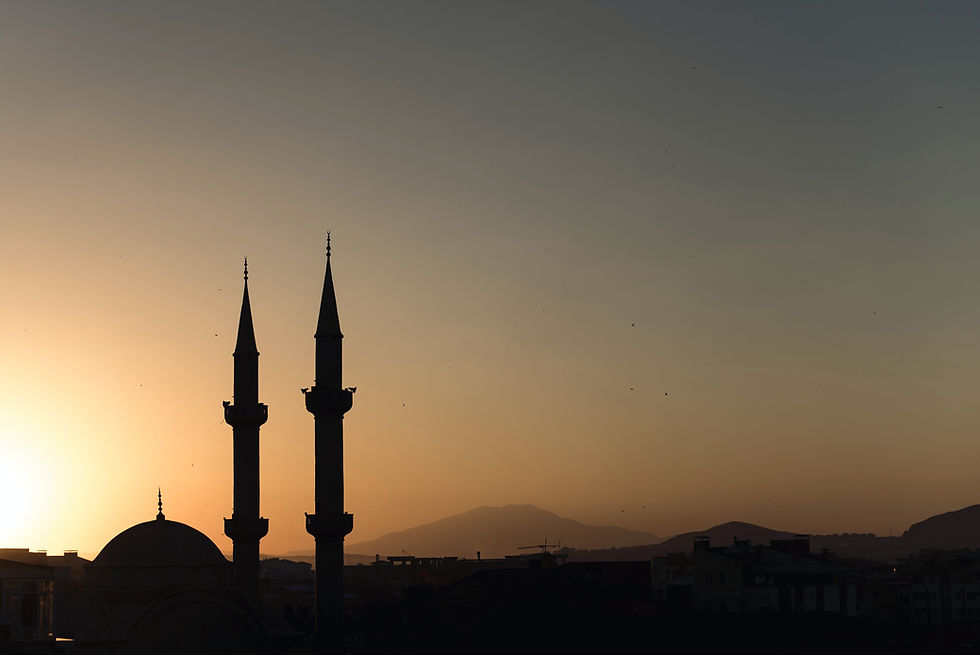

The Message
In or about the year 570 the child who would be named Muhammad and who would become the Prophet of one of the world’s great religions, Islam, was born into a family belonging to a clan of Quraysh, the ruling tribe of Mecca, a city in the Hijaz region of northwestern Arabia.
Originally the site of the Ka’bah, a shrine of ancient origins, Mecca had with the decline of southern Arabia (see Chapter l ) become an important center of sixth-century trade with such powers as the Sassanians, Byzantines, and Ethiopians. As a result the city was dominated by powerful merchant families among whom the men of Quraysh were preeminent.
Muhammad’s father, ‘Abd Allah ibn’Abd al-Muttalib, died before the boy was born; his mother, Aminah, died when he was six. The orphan was consigned to the care of his grandfather, the head of the clan of Hashim. After the death of his grandfather, Muhammad was raised by his uncle, Abu Talib. As was customary, Muhammad as a child was sent to live for a year or two with a Bedouin family. This custom, followed until recently by noble families of Mecca, Medina, Tayif, and other towns of the Hijaz, had important implications for Muhammad. In addition to enduring the hardships of desert life, he acquired a taste for the rich language so loved by the Arabs, whose speech was their proudest art, and learned the patience and forbearance of the herdsmen, whose life of solitude he first shared and then came to understand and appreciate.
About the year 590, Muhammad, then in his twenties, entered the service of a widow named Khadijah as a merchant actively engaged with trading caravans to the north. Sometime later Muhammad married Khadijah, by whom he had two sons – who did not survive – and four daughters.
During this period of his life Muhammad traveled widely. Then, in his forties he began to retire to meditate in a cave on Mount Hira outside of Mecca, where the first of the great events of Islam took place. One day, as he sat in the cave, he heard a voice, later identified as that of the Angel Gabriel, which ordered him to:
Recite: In the name of thy Lord who created, Created man from a clot of blood.
Three times Muhammad pleaded his inability to do so, but each time the command was repeated. Finally, Muhammad recited the words of what are now the first five verses of the 96th surah or chapter of the Quran – words which proclaim God the Creator of man and the Source of all knowledge.
At first Muhammad divulged his experience only to his wife and his immediate circle. But as more revelations enjoined him to proclaim the oneness of God universally, his following grew, at first among the poor and the slaves, but later also among the most prominent men of Mecca. The revelations he received at this time and those he did so later are all incorporated in the Quran, the Scripture of Islam.

Photo: The sun rises over Jabal al-Rahmah, the Mount of Mercy, where Muhammad in his farewell sermon told the assembled Muslims, “I have delivered God’s message to you and left you with a clear command: the Book of God and the practice of His Prophet. If you hold fast to this you will never go astray.”
Not everyone accepted God’s message transmitted through Muhammad. Even in his own clan there were those who rejected his teachings, and many merchants actively opposed the message. The opposition, however, merely served to sharpen Muhammad’s sense of mission and his understanding of exactly how Islam differed from paganism. The belief in the unity of God was paramount in Islam; from this all else followed. The verses of the Quran stress God’s uniqueness, warn those who deny it of impending punishment, and proclaim His unbounded compassion to those who submit to His will. They affirm the Last Judgment, when God, the Judge, will weigh in the balance the faith and works of each man, rewarding the faithful and punishing the transgressor. Because the Quran rejected polytheism and emphasized man’s moral responsibility, in powerful images, it presented a grave challenge to the worldly Meccans.

The Hijrah
After Muhammad had preached publicly for more than a decade, the opposition to him reached such a high pitch that, fearful for their safety, he sent some of his adherents to Ethiopia, where the Christian ruler extended protection to them, the memory of which has been cherished by Muslims ever since. But in Mecca the persecution worsened. Muhammad’s followers were harassed, abused, and even tortured. At last, therefore, Muhammad sent seventy of his followers off to the northern town of Yathrib, which was later to be renamed Medina (“The City”). Later, in the early fall of 622, he learned of a plot to murder him and, with his closest friend, Abu Bakr al-Siddiq, set off to join the emigrants.
In Mecca the plotters arrived at Muhammad’s home to find that his cousin, ‘Ali, had taken his place in bed. Enraged, the Meccans set a price on Muhammad’s head and set off in pursuit. Muhammad and Abu Bakr, however, had taken refuge in a cave where, as they hid from their pursuers, a spider spun its web across the cave’s mouth. When they saw that the web was unbroken, the Meccans passed by and Muhammad and Abu Bakr went on to Medina, where they were joyously welcomed by a throng of Medinans as well as the Meccans who had gone ahead to prepare the way.
This was the Hijrah – anglicized as Hegira – usually, but inaccurately, translated as “Flight” – from which the Muslim era is dated. In fact, the Hijrah was not a flight but a carefully planned migration which marks not only a break in history – the beginning of the Islamic era- but also, for Muhammad and the Muslims, a new way of life. Henceforth, the organizational principle of the community was not to be mere blood kinship, but the greater brotherhood of all Muslims. The men who accompanied Muhammad on the Hijrah were called the Muhajirun – “those that made the Hijrah” or the “Emigrants” – while those in Medina who became Muslims were called the Ansar or “Helpers.”
Muhammad was well acquainted with the situation in Medina. Earlier, before the Hijrah, the city had sent envoys to Mecca asking Muhammad to mediate a dispute between two powerful tribes. What the envoys saw and heard had impressed them and they had invited Muhammad to settle in Medina. After the Hijrah, Muhammad’s exceptional qualities so impressed the Medinans that the rival tribes and their allies temporarily closed ranks as, on March 15, 624, Muhammad and his supporters moved against the pagans of Mecca.
Photo: A colonnade of lofty arches surrounds the courtyard at the Prophet’s Mosque in Medina, after Mecca the second holiest city of Islam.
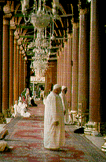
The first battle, which took place near Badr, now a small town southwest of Medina, had several important effects. In the first place, the Muslim forces, outnumbered three to one, routed the Meccans. Secondly, the discipline displayed by the Muslims brought home to the Meccans, perhaps for the first time, the abilities of the man they had driven from their city. Thirdly, one of the allied tribes which had pledged support to the Muslims in the Battle of Badr, but had then proved lukewarm when the fighting started, was expelled from Medina one month after the battle. Those who claimed to be allies of the Muslims, but tacitly opposed them, were thus served warning: membership in the community imposed the obligation of total support.
A year later the Meccans struck back. Assembling an army of three thousand men, they met the Muslims at Uhud, a ridge outside Medina. After an initial success the Muslims were driven back and the Prophet himself was wounded. As the Muslims were not completely defeated, the Meccans, with an army of ten thousand, attacked Medina again two years later but with quite different results. At the Battle of the Trench, also known as the Battle of the Confederates, the Muslims scored a signal victory by introducing a new defense. On the side of Medina from which attack was expected they dug a trench too deep for the Meccan cavalry to clear without exposing itself to the archers posted behind earthworks on the Medina side. After an inconclusive siege, the Meccans were forced to retire. Thereafter Medina was entirely in the hands of the Muslims.
The Constitution of Medina – under which the clans accepting Muhammad as the Prophet of God formed an alliance, or federation – dates from this period. It showed that the political consciousness of the Muslim community had reached an important point; its members defined themselves as a community separate from all others. The Constitution also defined the role of non-Muslims in the community. Jews, for example, were part of the community; they were dhimmis, that is, protected people, as long as they conformed to its laws. This established a precedent for the treatment of subject peoples during the later conquests. Christians and Jews, upon payment of a yearly tax, were allowed religious freedom and, while maintaining their status as non-Muslims, were associate members of the Muslim state. This status did not apply to polytheists, who could not be tolerated within a community that worshipped the One God.
Photo: The Ka’bah, spiritual axis of the Muslim world, stands in the courtyard of Mecca’s Sacred Mosque.

Ibn Ishaq, one of the earliest biographers of the Prophet, says it was at about this time that Muhammad sent letters to the rulers of the earth – the King of Persia, the Emperor of Byzantium, the Negus of Abyssinia, and the Governor of Egypt among others – inviting them to submit to Islam. Nothing more fully illustrates the confidence of the small community, as its military power, despite the battle of the Trench, was still negligible. But its confidence was not misplaced. Muhammad so effectively built up a series of alliances among the tribes his early years with the Bedouins must have stood him in good stead here- that by 628 he and fifteen hundred followers were able to demand access to the Ka’bah during negotiations with the Meccans. This was a milestone in the history of the Muslims. Just a short time before, Muhammad had to leave the city of his birth in fear of his life. Now he was being treated by his former enemies as a leader in his own right. A year later, in 629, he reentered and, in effect, conquered Mecca without bloodshed and in a spirit of tolerance which established an ideal for future conquests. He also destroyed the idols in the Ka’bah, to put an end forever to pagan practices there. At the same time Muhammad won the allegiance of ‘Amr ibn al-‘As, the future conqueror of Egypt, and Khalid ibn al-Walid, the future “Sword of God,” both of whom embraced Islam and joined Muhammad. Their conversion was especially noteworthy because these men had been among Muhammad’s bitterest opponents only a short time before.
In one sense Muhammad’s return to Mecca was the climax of his mission. In 632, just three years later, he was suddenly taken ill and on June 8 of that year, with his third wife ‘Aishah in attendance, the Messenger of God “died with the heat of noon.”
Photo: Devout Muslims from all over the world gather for the pilgrimage to Mecca, for nearly fourteen centuries one of the most impressive religious gatherings in the world.

The death of Muhammad was a profound loss. To his followers this simple man from Mecca was far more than a beloved friend, far more than a gifted administrator, far more than the revered leader who had forged a new state from clusters of warring tribes. Muhammad was also the exemplar of the teachings he had brought them from God: the teachings of the Quran, which, for centuries, have guided the thought and action, the faith and conduct, of innumerable men and women, and which ushered in a distinctive era in the history of mankind. His death, nevertheless, had little effect on the dynamic society he had created in Arabia, and no effect at all on his central mission: to transmit the Quran to the world. As Abu Bakr put it: “Whoever worshipped Muhammad, let him know that Muhammad is dead, but whoever worshipped God, let him know that God lives and dies not.”

The Rightly Guided Caliphs
With the death of Muhammad, the Muslim community was faced with the problem of succession. Who would be its leader? There were four persons obviously marked for leadership: Abu Bakr al-Siddiq, who had not only accompanied Muhammad to Medina ten years before, but had been appointed to take the place of the Prophet as leader of public prayer during Muhammad’s last illness; ‘Umar ibn al-Khattab, an able and trusted Companion of the Prophet; ‘Uthman ibn ‘Affan, a respected early convert; and ‘Ali ibn Abi Talib, Muhammad’s cousin and son-in-law. To avoid contention among various groups, ‘Umar suddenly grasped Abu Bakr’s hand, the traditional sign of recognition of a new leader. Soon everyone concurred and before dusk Abu Bakr had been recognized as the khalifah of Muhammad. Khalifah- anglicized as caliph – is a word meaning “successor” but also suggesting what his historical role would be: to govern according to the Quran and the practice of the Prophet.
Abu Bakr’s caliphate was short but important. An exemplary leader, he lived simply, assiduously fulfilled his religious obligations, and was accessible and sympathetic to his people. But he also stood firm when, in the wake of the Prophet’s death, some tribes renounced Islam; in what was a major accomplishment, Abu Bakr swiftly disciplined them. Later, he consolidated the support of the tribes within the Arabian Peninsula and subsequently funnelled their energies against the powerful empires of the East: the Sassanians in Persia and the Byzantines in Syria, Palestine, and Egypt. In short, he demonstrated the viability of the Muslim state.
The second caliph, ‘Umar- appointed by Abu Bakr in a written testament – continued to demonstrate that viability. Adopting the title Amir al-Muminin, “Commander of the Believers,” ‘Umar extended Islam’s temporal rule over Syria, Egypt, Iraq, and Persia in what from a purely military standpoint were astonishing victories. Within four years after the death of the Prophet the Muslim state had extended its sway over all of Syria and had, at a famous battle fought during a sandstorm near the River Yarmuk, blunted the power of the Byzantines – whose ruler Heraclius had shortly before disdainfully rejected the letter from the unknown Prophet of Arabia.
Even more astonishingly, the Muslim state administered the conquered territories with a tolerance almost unheard of in that age. At Damascus, for example, the Muslim leader Khalid ibn al-Walid signed a treaty which read as follows:
This is what Khalid ibn al-Walid would grant to the inhabitants of Damascus if he enters therein: he promises to give them security for their lives, property and churches. Their city wall shall not be demolished, neither shall any Muslim be quartered in their houses. Thereunto we give them the pact of Allah and the protection of His Prophet, the caliphs and the believers. So long as they pay the poll tax, nothing but good shall befall them.
This tolerance was typical of Islam. A year after Yarmuk, ‘Umar, in the military camp of al-Jabiyah on the Golan Heights, received word that the Byzantines were ready to surrender Jerusalem and rode there to accept the surrender in person. According to one account, he entered the city alone and clad in a simple cloak, astounding a populace accustomed to the sumptuous garb and court ceremonials of the Byzantines and Persians. He astounded them still further when he set their fears at rest by negotiating a generous treaty in which he told them:
In the name of God … you have complete security for your churches which shall not be occupied by the Muslims or destroyed.
This policy was to prove successful everywhere. In Syria, for example, many Christians who had been involved in bitter theological disputes with Byzantine authorities- and persecuted for it- welcomed the coming of Islam as an end to tyranny. And in Egypt, which ‘Amr ibn al-‘As took from the Byzantines after a daring march across the Sinai Peninsula, the Coptic Christians not only welcomed the Arabs, but enthusiastically assisted them.
This pattern was repeated throughout the Byzantine Empire. Conflict among Greek Orthodox, Syrian Monophysites, Copts, and Nestorian Christians contributed to the failure of the Byzantines – always regarded as intruders – to develop popular support, while the tolerance which Muslims showed toward Christians and Jews removed the primary cause for opposing them.
‘Umar adopted this attitude in administrative matters as well. Although he assigned Muslim governors to the new provinces, existing Byzantine and Persian administrations were retained wherever possible. For fifty years, in fact, Greek remained the chancery language of Syria, Egypt, and Palestine, while Pahlavi, the chancery language of the Sassanians, continued to be used in Mesopotamia and Persia.
‘Umar, who served as caliph for ten years, ended his rule with a significant victory over the Persian Empire. The struggle with the Sassanid realm had opened in 687 at al-Qadisiyah, near Ctesiphon in Iraq, where Muslim cavalry had successfully coped with elephants used by the Persians as a kind of primitive tank. Now with the Battle of Nihavand, called the “Conquest of Conquests,” ‘Umar sealed the fate of Persia; henceforth it was to be one of the most important provinces in the Muslim Empire.
His caliphate was a high point in early Islamic history. He was noted for his justice, social ideals, administration, and statesmanship. His innovations left all enduring imprint on social welfare, taxation, and the financial and administrative fabric of the growing empire.
After the death of ‘Umar an advisory council composed of Companions of the Prophet selected as the third caliph ‘Uthman, during whose rule the first serious strains on Islamic unity would appear. ‘Uthman achieved much during his reign. He pushed forward with the pacification of Persia, continued to defend the Muslim state against the Byzantines, added what is now Libya to the empire, and subjugated most of Armenia. ‘Uthman also, through his cousin Mu’awiyah ibn Abi Sufyan, the governor of Syria, established an Arab navy which fought a series of important engagements with the Byzantines.
Of much greater importance to Islam, however, was ‘Uthman’s compilation of the text of the Quran as revealed to the Prophet. Realizing that the original message from God might be inadvertently distorted by textual variants, he appointed a committee to collect the canonical verses and destroy the variant recensions. The result was the text that is accepted to this day throughout the Muslim world.
Photo: This eighth century manuscript from Mecca or Medina is one of the two oldest known existing copies of the Quran.

These successes, however, were qualified by serious administrative weaknesses. ‘Uthman was accused of favoritism to members of his family – the clan of Umayyah. Negotiations over such grievances were opened by representatives from Egypt but soon collapsed and ‘Uthman was killed – an act that caused a rift in the community of Islam that has never entirely been closed.
This rift widened almost as soon as ‘Ali, cousin and son-in-law of the Prophet, was chosen to be the fourth caliph. At issue, essentially, was the legitimacy of ‘Ali’s caliphate. ‘Uthman’s relatives – in particular Mu’awiyah, the powerful governor of Syria, where ‘Ali’s election had not been recognized – believed ‘Ali’s caliphate was invalid because his election had been supported by those responsible for ‘Uthman’s unavenged death. The conflict came to a climax in 657 at Siffin, near the Euphrates, and eventually resulted in a major division between the Sunnis or Sunnites and the Shi’is (also called Shi’ites or Shi’ah), the “Partisans” of ‘Ali- a division that was to color the subsequent history of Islam.
Actually the Sunnis and the Shi’is are agreed upon almost all the essentials of Islam. Both believe in the Quran and the Prophet, both follow the same principles of religion and both observe the same rituals. However, there is one prominent difference, which is essentially political rather than religious, and concerns the choice of the caliph or successor of Muhammad.
The majority of Muslims support the elective principle which led to the choice of Abu Bakr as the first caliph. This group is known as ahl alsunnah wa-l-jama’ah, “the people of custom and community,” or Sunnis, who consider the caliph to be Muhammad’s successor only in his capacity as ruler of the community. The main body of the Shi’is, on the other hand, believes that the caliphate – which they call the imamate or “leadership” – is nonelective. The caliphate, they say, must remain within the family of the Prophet – with ‘Ali the first valid caliph. And while Sunnis consider the caliph a guardian of the shari’ah, the religious law, the Shi’is see the imam as a trustee inheriting and interpreting the Prophet’s spiritual knowledge.
After the battle of Siffin, ‘Ali – whose chief strength was in Iraq, with his capital at Kufa – began to lose the support of many of his more uncompromising followers and in 661 he was murdered by a former supporter. His son Hasan was proclaimed caliph at Kufa but soon afterward deferred to Muiawiyah, who had already been proclaimed caliph in Jerusalem in the previous year and who now was recognized and accepted as caliph in all the Muslim territories – thus inaugurating the Umayyad dynasty which would rule for the next ninety years.
The division between the Sunnis and the Shi’is continued to develop in 680 when Ali’s son Husayn along with his followers was brutally killed at Karbala in Iraq by the forces of the Umayyad ruler Yazid. His death is still commemorated every year during the Islamic month of Muharram.

The Umayyads
The shift in power to Damascus, the Umayyad capital city, was to have profound effects on the development of Islamic history. For one thing, it was a tacit recognition of the end of an era. The first four caliphs had been without exception Companions of the Prophet – pious, sincere men who had lived no differently from their neighbors and who preserved the simple habits of their ancestors despite the massive influx of wealth from the conquered territories. Even ‘Uthman, whose policies had such a divisive effect, was essentially dedicated more to the concerns of the next world than of this. With the shift to Damascus much was changed.
In the early days of Islam, the extension of Islamic rule had been based on an uncomplicated desire to spread the Word of God. Although the Muslims used force when they met resistance they did not compel their enemies to accept Islam. On the contrary, the Muslims permitted Christians and Jews to practice their own faith and numerous conversions to Islam were the result of exposure to a faith that was simple and inspiring.
Photo: Medieval Muslims regarded the Great Mosque built by the Umayyads in Damascus as one of the wonders of the world.

With the advent of the Umayyads, how ever, secular concerns and the problems inherent in the administration of what, by then, was a large empire began to dominate the attention of the caliphs, often at the expense of religious concerns – a development that disturbed many devout Muslims. This is not to say that religious values were ignored; on the contrary, they grew in strength for centuries. But they were not always at the forefront and from the time of Mu’awiyah the caliph’s role as “Defender of the Faith” increasingly required him to devote attention to the purely secular concerns which dominate so much of every nation’s history.
Muiawiyah was an able administrator, and even his critics concede that he possessed to a high degree the much-valued quality of hilm – a quality which may be defined as “civilized restraint” and which he himself once described in these words:
I apply not my sword where my lash suffices, nor my lash where my tongue is enough. And even if there be one hair binding me to my fellowmen, I do not let it break: when they pull I loosen, and if they loosen I pull.
Nevertheless, Mu’awiyah was never able to reconcile the opposition to his rule nor solve the conflict with the Shi’is. These problems were not unmanageable while Mu’awiyah was alive, but after he died in 680 the partisans of ‘Ali resumed a complicated but persistent struggle that plagued the Umayyads at home for most of the next seventy years and in time spread into North Africa and Spain.
Photo: Facing al-Gharbiyah, the western minaret, a muezzin at the Umayyad Mosque calls believers to prayer.
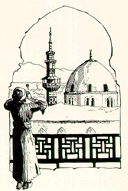
The Umayyads, however, did manage to achieve a degree of stability, particularly after ‘Abd al-Malik ibn Marwan succeeded to the caliphate in 685. Like the Umayyads who preceded him, ‘Abd al-Malik was forced to devote a substantial part of his reign to political problems. But he also introduced much needed reforms. He directed the cleaning and reopening of the canals that irrigated the Tigris-Euphrates Valley – a key to the prosperity of Mesopotamia since the time of the Sumerians – introduced the use of the Indian water buffalo in the riverine marshes, and minted a standard coinage which replaced the Byzantine and Sassanid coins, until then the sole currencies in circulation. ‘Abd al-Malik’s organization of government agencies was also important; it established a model for the later elaborate bureaucracies of the ‘Abbasids and their successor states. There were specific agencies charged with keeping pay records; others concerned themselves with the collection of taxes. ‘Abd al-Malik established a system of postal routes to expedite his communications throughout the far flung empire. Most important of all, he introduced Arabic as the language of administration, replacing Greek and Pahlavi.
Under ‘Abd al-Malik, the Umayyads expanded Islamic power still further. To the east they extended their influence into Transoxania, an area north of the Oxus River in today’s Soviet Union, and went on to reach the borders of China. To the west, they took North Africa, in a continuation of the campaign led by ‘Uqbah ibn Nafi’ who founded the city of Kairouan – in what is now Tunisia – and from there rode all the way to the shores of the Atlantic Ocean.
These territorial acquisitions brought the Arabs into contact with previously unknown ethnic groups who embraced Islam and would later influence the course of Islamic history. The Berbers of North Africa, for example, who resisted Arab rule but willingly embraced Islam, later joined Musa ibn Nusayr and his general, Tariq ibn Ziyad, when they crossed the Strait of Gibraltar to Spain. The Berbers later also launched reform movements in North Africa which greatly influenced the Islamic civilization. In the East, Umayyad rule in Transoxania brought the Arabs into contact with the Turks who, like the Berbers, embraced Islam and, in the course of time, became its staunch defenders. Umayyad expansion also reached the ancient civilization of India, whose literature and science greatly enriched Islamic culture.
Photo: The minaret of the Great Mosque at Kairouan in Tunisia became the prototype for the majority of North African minarets.

In Europe, meanwhile, the Arabs had passed into Spain, defeated the Visigoths, and by 713 had reached Narbonne in France. In the next decades, raiding parties continually made forays into France and in 732 reached as far as the Loire Valley, only 170 miles from Paris. There, at the Battle of Tours, or Poitiers, the Arabs were finally turned back by Charles Martel.
One of the Umayyad caliphs who attained greatness was ‘Umar ibn ‘Abd al-‘Aziz, a man very different from his predecessors. Although a member of the Umayyad family, ‘Umar had been born and raised in Medina, where his early contact with devout men had given him a concern for spiritual as well as political values. The criticisms that religious men in Medina and elsewhere had voiced of Umayyad policy – particularly the pursuit of worldly goals – were not lost on ‘Umar who, reversing the policy of his predecessors, discontinued the levy of a poll tax on converts.
This move reduced state income substantially, but as there was clear precedent in the practice of the great ‘Umar ibn al-Khattab, the second caliph, and as ‘Umar ibn ‘Abd al-‘Aziz was determined to bring government policy more in line with the practice of the Prophet, even enemies of his regime had nothing but praise for this pious man.
The last great Umayyad caliph was Hisham, the fourth son of ‘Abd al-Malik to succeed to the caliphate. His reign was long – from 724 to 743 – and during it the Arab empire reached its greatest extent. But neither he nor the four caliphs who succeeded him were the statesmen the times demanded when, in 747, revolutionaries in Khorasan unfurled the black flag of rebellion that would bring the Umayyad Dynasty to an end.
Although the Umayyads favored their own region of Syria, their rule was not without accomplishments. Some of the most beautiful existing buildings in the Muslim world were constructed at their instigation – buildings such as the Umayyad Mosque in Damascus, the Dome of the Rock in Jerusalem, and the lovely country palaces in the deserts of Syria, Jordan, and Iraq. They also organized a bureaucracy able to cope with the complex problems of a vast and diverse empire, and made Arabic the language of government. The Umayyads, furthermore, encouraged such writers as ‘Abd Allah ibn al-Muqaffa’ and ‘Abd al-Hamid ibn Yahya al-Katib, whose clear, expository Arabic prose has rarely been surpassed.
Photo: The shrine of the Dome of the Rock in Jerusalem, built in an area revered by Muslims, Christians and Jews alike covers the rock from which Muhammad is believed to have ascended to heaven with the Angel Gabriel.

For all that, the Umayyads, during the ninety years of their leadership, rarely shook off their empire’s reputation as a mulk – that is, a worldly kingdom – and in the last years of the dynasty their opponents formed a secret organization devoted to pressing the claims to the caliphate put forward by a descendant of al-‘Abbas ibn ‘Abd al-Muttalib, an uncle of the Prophet. By skillful preparation, this organization rallied to its cause many mutually hostile groups in Khorasan and Iraq and proclaimed Abu al-‘Abbas caliph. Marwan ibn Muhammad, the last Umayyad caliph, was defeated and the Syrians, still loyal to the Umayyads, were put to rout. Only one man of importance escaped the disaster – ‘Abd al-Rahman ibn Mu’awiyah al-Dakhil, a young prince who with a loyal servant fled to Spain and in 756 set up an Umayyad Dynasty there.

Islam in Spain
By the time ‘Abd al-Rahman reached Spain, the Arabs from North Africa were already entrenched on the Iberian Peninsula and had begun to write one of the most glorious chapters in Islamic history.
After their forays into France were blunted by Charles Martel, the Muslims in Spain had begun to focus their whole attention on what they called al-Andalus, southern Spain (Andalusia), and to build there a civilization far superior to anything Spain had ever known. Reigning with wisdom and justice, they treated Christians and Jews with tolerance, with the result that many embraced Islam. They also improved trade and agriculture, patronized the arts, made valuable contributions to science, and established Cordoba as the most sophisticated city in Europe.
By the tenth century, Cordoba could boast of a population of some 500,000, compared to about 38,000 in Paris. According to the chronicles of the day, the city had 700 mosques, some 60,000 palaces, and 70 libraries – one reportedly housing 500,000 manuscripts and employing a staff of researchers, illuminators, and book binders. Cordoba also had some 900 public baths, Europe’s first street lights and, five miles outside the city, the caliphal residence, Madinat al-Zahra. A complex of marble, stucco, ivory, and onyx, Madinat al-Zahra took forty years to build, cost close to one-third of Cordoba’s revenue, and was, until destroyed in the eleventh century, one of the wonders of the age. Its restoration, begun in the early years of this century, is still under way.
Photo: A forest of eight hundred and fifty pillars connected by Moorish arches lines the great mosque of Cordoba.

By the eleventh century, however, a small pocket of Christian resistance had begun to grow, and under Alfonso VI Christian forces retook Toledo. It was the beginning of the period the Christians called the Reconquest, and it underlined a serious problem that marred this refined, graceful, and charming era: the inability of the numerous rulers of Islamic Spain to maintain their unity. This so weakened them that when the various Christian kingdoms began to pose a serious threat, the Muslim rulers in Spain had to ask the Almoravids, a North African Berber dynasty, to come to their aid. The Almoravids came and crushed the Christian uprising, but eventually seized control themselves. In 1147, the Almoravids were in turn defeated by another coalition of Berber tribes, the Almohads.
Although such internal conflict was by no means uncommon- the Christian kingdoms also warred incessantly among themselves- it did divert Muslim strength at a time when the Christians were beginning to negotiate strong alliances, form powerful armies, and launch the campaigns that would later bring an end to Arab rule.
The Arabs did not surrender easily; al-Andalus was their land too. But, bit by bit, they had to retreat, first from northern Spain, then from central Spain. By the thirteenth century their once extensive domains were reduced to a few scattered kingdoms deep in the mountains of Andalusia – where, for some two hundred years longer, they would not only survive but flourish.
It is both odd and poignant that it was then, in the last two centuries of their rule, that the Arabs created that extravagantly lovely kingdom for which they are most famous: Granada. It seems as if, in their slow retreat to the south, they suddenly realized that they were, as Washington Irving wrote, a people without a country, and set about building a memorial: the Alhambra, the citadel above Granada that one writer has called “the glory and the wonder of the civilized world.”
The Alhambra was begun in 1238 by Muhammad ibn al-Ahmar who, to buy safety for his people when King Ferdinand of Aragon laid siege to Granada, once rode to Ferdinand’s tent and humbly offered to become the king’s vassal in return for peace.
Photo: Pool in the Patio de los Arrayanes reflects the grandeur of the incomparable Alhambra.

It was a necessary move, but also difficult – particularly when Ferdinand called on him to implement the agreement by providing troops to help the Christians against Muslims in the siege of Seville in 1248. True to his pledge, Ibn al-Ahmar complied and Seville fell to the Christians. But returning to Granada, where cheering crowds hailed him as a victor, he disclosed his turmoil in that short, sad reply that he inscribed over and over on the walls of the Alhambra: “There is no victor but God.”
Over the years, what started as a fortress slowly evolved under Ibn al-Ahmar’s successors into a remarkable series of delicately lovely buildings, quiet courtyards, limpid pools, and hidden gardens. Later, after Ibn al-Ahmar’s death, Granada itself was rebuilt and became, as one Arab visitor wrote, “as a silver vase filled with emeralds.”
Meanwhile, outside Granada, the Christian kings waited. In relentless succession they had retaken Toledo, Cordoba, and Seville. Only Granada survived. Then, in 1482, in a trivial quarrel, the Muslim kingdom split into two hostile factions and, simultaneously, two strong Christian sovereigns, Ferdinand and Isabella, married and merged their kingdoms. As a result, Granada fell ten years later. On January 2, 1492 – the year they sent Columbus to America – Ferdinand and Isabella hoisted the banner of Christian Spain above the Alhambra and Boabdil, the last Muslim king, rode weeping into exile with the bitter envoi from his aged mother, “Weep like a woman for the city you would not defend like a man!”
Photo: A Moorish-built tower soars above Guadalquivir River in Seville.

In describing the fate of Islam in Spain, Irving suggested that the Muslims were then swiftly and thoroughly wiped out. Never, he wrote, was the annihilation of a people more complete. In fact, by emigration to North Africa and elsewhere, many Muslims carried remnants of the Spanish era with them and were thus able to make important contributions to the material and cultural life of their adopted lands.
Much of the emigration, however, came later. At first, most Muslims simply stayed in Spain; cut off from their original roots by time and distance they quite simply had no other place to go. Until the Inquisition, furthermore, conditions in Spain were not intolerable. The Christians permitted Muslims to work, serve in the army, own land, and even practice their religion – all concessions to the importance of Muslims in Spain’s still prosperous economy. But then, in the period of the Inquisition, all the rights of the Muslims were withdrawn, their lives became difficult, and more began to emigrate. Finally, in the early seventeenth century, most of the survivors were forcibly expelled.

The Abbasids
In the Middle East, during these centuries, the ‘Abbasids, after their victory over the Umayyads, had transformed the Umayyads’ Arab empire into a multinational Muslim empire. They moved the capital of the empire from Syria to Iraq, where they built a new capital, Baghdad, from which, during the next five centuries, they would influence many of the main events of Islamic history.
In the early period of ‘Abbasid rule, al-Mansur, the second caliph of the dynasty, continued the reorganization of the administration of the empire along the lines that had been laid down by his Umayyad predecessor, ‘Abd al-Malik. Much of the ‘Abbasid administration, for example, was left in the hands of well-educated Persian civil servants, many of whom came from families that had traditionally served the Sassanid kings. The important office of wazir or vizier, chief counselor, may well have developed from Sassanid models. The vizier was much more than an advisor; indeed, when the caliph was weak, a capable vizier became the most powerful man in the empire.
Photo: Astride the Tigris, present day Baghdad stands in the vicinity of the ‘Abbasid capital, a fabulous city of mosques, mansions and libraries.

The creation of the office of the vizier was only one of the innovations the ‘Abbasids brought to statecraft. Another was the development of the Umayyad postal system into an efficient intelligence service; postmasters in outlying provinces were the eyes and ears of the government and regular reports were filed with the central government on everything from the state of the harvest to the doings of dissident sects. Under the ‘Abbasids too a whole literature was created for the use and training of the clerical classes that had come into being. Since all government business was by now transacted in Arabic, manuals of correct usage were written for the instruction of non-Arabic speakers who had found government employment. There was also a vast literature on the correct deportment of princes, as well as anthologies of witty sayings and anecdotes with which to enliven one’s epistolary style.
Photo: The Great Mosque of the Umayyads in Damascus dates from the early eighth century and numerous works of rebuilding have not changed its fundamental character.

In some ways the ‘Abbasids were more fortunate than the Umayyads. When, for example, al-Mansur died in 775 after a reign of twenty years, his son, al-Mahdi, inherited a full treasury and an empire that was more devoted to trade than war.
The developments in trade, indeed, are among the achievements of the ‘Abbasids that are too often overlooked. Because Islamic rule unified much of the Eastern world, thus abolishing many boundaries, trade was freer, safer, and more extensive than it had been since the time of Alexander the Great. Muslim traders, consequently, established trading posts as far away as India, the Philippines, Malaya, the East Indies, and China.
Photo: Golden domes and gold topped minarets highlight the mosque of al-Kazimayn in Baghdad, built in the early sixteenth century.

From the eighth to the eleventh centuries this trade was largely concerned with finding and importing basic necessities- grain, metals, and wood. To obtain them, of course, the Muslims had to export too, often using the imports from one region as exports to another: pearls from the Gulf, livestock from the Arabian Peninsula (particularly Arabian horses and camels), and – one of the chief products – cloth. The Muslims also traded medicines, an offshoot of ‘Abbasid advances in medical science, as well as paper and sugar.
Photo: The mosque of Bibi Khanum named for Tamerlane’s favorite wife, was once the most imposing building of Samarkand.
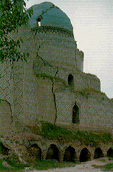
This expansion of commercial activity led to other developments too. One was a system of banking and exchange so sophisticated that a letter of credit issued in Baghdad could be honored in Samarkand in Central Asia or Kairouan in North Africa. The demands on trade also generated development of crafts. From Baghdad’s large urban population, for example, came craftsmen of every conceivable sort: metalworkers, leatherworkers, bookbinders, papermakers, jewelers, weavers, druggists, bakers, and many more. As they grew in importance to the economy these craftsmen eventually organized themselves into mutual-benefit societies which in some ways were similar to later Western guilds and which offered many social services: lodging travelers, engaging in pious works such as caring for orphans, and endowing schools. Because of this growth in commerce the ‘Abbasids also developed a system by which a muhtasib, an inspector made sure that proper weights and measures were given and that dishonest practices of all sorts were avoided.

The Golden Age
The early ‘Abbasids were also fortunate in the caliber of their caliphs, especially after Harun al-Rashid came to the caliphate in 786. His reign is now the most famous in the annals of the ‘Abbasids – partly because of the fictional role given him in The Thousand and One Nights (portions of which probably date from his reign), but also because his reign and those of his immediate successors marked the high point of the ‘Abbasid period. As the Arab chronicles put it, Harun al-Rashid ruled when the world was young, a felicitous description of what in later times has come to be called the Golden Age of Islam.
The Golden Age was a period of unrivaled intellectual activity in all fields: science, technology, and (as a result of intensive study of the Islamic faith) literature – particularly biography, history, and linguistics. Scholars, for example, in collecting and reexamining the hadith, or “traditions” – the sayings and actions of the Prophet – compiled immense biographical detail about the Prophet and other information, historic and linguistic, about the Prophet’s era. This led to such memorable works as Sirat Rasul Allah, the “Life of the Messenger of God,” by Ibn Ishaq, later revised by Ibn Hisham; one of the earliest Arabic historical works, it was a key source of information about the Prophet’s life and also a model for other important works of history such as al-Tabari’s Annals of the Apostles and the Kings and his massive commentary on the Quran.
Photo: Persian miniature depicts students with a teacher of astronomy – one of the sciences to which scholars of the Golden Age made great contributions.
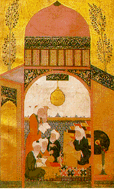
‘Abbasid writers also developed new a genres of literature such as adab, the embodiment of sensible counsel, sometimes in the form of animal fables; a typical example is Kalilah wa-Dimnah, translated by Ibn al-Muqaffa’ from a Pahlavi version of an Indian work. Writers of this period also studied tribal traditions and wrote the first systematic Arabic grammars.
During the Golden Age Muslim scholars also made important and original contributions to mathematics, astronomy, medicine, and chemistry. They collected and corrected previous astronomical data, built the world’s first observatory, and developed the astrolabe, an instrument that was once called “a mathematical jewel.” In medicine they experimented with diet, drugs, surgery, and anatomy, and in chemistry, an outgrowth of alchemy, isolated and studied a wide variety of minerals and compounds.
Important advances in agriculture were also made in the Golden Age. The ‘Abbasids preserved and improved the ancient network of wells, underground canals, and waterwheels, introduced new breeds of livestock, hastened the spread of cotton, and, from the Chinese, learned the art of making paper, a key to the revival of learning in Europe in the Middle Ages.
The Golden Age also, little by little, transformed the diet of medieval Europe by introducing such plants as plums, artichokes, apricots, cauliflower, celery, fennel, squash, pumpkins, and eggplant, as well as rice, sorghum, new strains of wheat, the date palm, and sugarcane.
Photo: Muslim scientists developed the astrolabe, an instrument used long before the invention of the sextant to observe the position of celestial bodies.

Many of the advances in science, literature, and trade which took place during the Golden Age of the ‘Abbasids and which would provide the impetus for the European Renaissance reached their flowering during the caliphate of al-Mamun, son of Harun al-Rashid and perhaps the greatest of all the ‘Abbasids. But politically the signs of decay were already becoming evident. The province of Ifriqiyah – North Africa west of Libya and east of Morocco – had fallen away from ‘Abbasid control during the reign of Harun al-Rashid, and under al-Mamun other provinces soon broke loose also. When, for example, al-Mamun marched from Khorasan to Baghdad, he left a trusted general named Tahir ibn al-Husayn in charge of the eastern province. Tahir asserted his independence of the central government by omitting mention of the caliph’s name in the mosque on Friday and by striking his own coins – acts which became the standard ways of expressing political independence. From 821 onward Tahir and his descendants ruled Khorasan as an independent state, with the tacit consent of the ‘Abbasids.
Al-Mamun died in 833, in the town of Tarsus, and was succeeded by his brother, al-Mu’tasim, under whose rule the symptoms of decline that had manifested themselves earlier grew steadily worse. As he could no longer rely on the loyalty of his army, al-Mu’tasim recruited an army of Turks from Transoxania and Turkestan. It was a necessary step, but its outcome was dominance of the caliphate by its own praetorian guard. In the years following 861, the Turks made and unmade rulers at will, a trend that accelerated the decline of the central authority. Although the religious authority of the ‘Abbasid caliphate remained unchallenged, the next four centuries saw political power dispersed among a large number of independent states: Tahirids, Saffarids, Samanids, Buwayhids, Ziyarids, and Ghaznavids in the east; Hamdanids in Syria and northern Mesopotamia; and Tulunids, Ikhshidids, and Fatimids in Egypt.
Photo: Books of fables, often illustrated, served a dual purpose to instruct and to entertain.

Some of these states made important contributions to Islamic culture. Under the Samanids, the Persian language, written in the Arabic alphabet, first reached the level of a literary language and poets like Rudaki, Daqiqi, and Firdausi flourished. The Ghaznavids patronized al-Biruni, one of the greatest and most original scholars of medival Islam, and the Hamdanids, a purely Arab dynasty, patronized such poets as al-Mutanabbi and philosophers like the great al-Farabi, whose work kept the flame of Arab culture alive in a difficult period. But in historical terms, only the Fatimids rivaled the preceding dynasties.

The Fatimids
The most stable of the successor dynasties founded in the ninth and tenth centuries was that of the Fatimids, a branch of Shi’is. The Fatimids won their first success in North Africa, where they established a rival caliphate at Raqqadah near Kairouan and, in 952, embarked on a period of expansion that within a few years took them to Egypt.
Photo: Founded in 970, the mosque of al-Azhar in Cairo is one of the earliest and finest examples of the Egyptian style in Islamic architecture.

For a time the Fatimids aspired to be rulers of the whole Islamic world, and their achievements were impressive. At their peak they ruled North Africa, the Red Sea coast, Yemen, Palestine, and parts of Syria. The Fatimids built the Mosque of al-Azhar in Cairo – from which developed al-Azhar University, now the oldest university in the world and perhaps the most influential Islamic school of higher learning. Fatimid merchants traded with Afghanistan and China and tried to divert some of Baghdad’s Arabian Gulf shipping to the Red Sea.
But the Fatimids’ dreams of gaining control of the Islamic heartland came to nothing, partly because many other independent states refused to support them and partly because they, like the ‘Abbasids in Baghdad, lost effective control of their own mercenaries. Such developments weakened the Fatimids, but thanks to a family of viziers of Armenian origin they were able to endure until the Ayyubid succession in the second half of the twelfth century – even in the face of the eleventh-century invasion by the Seljuk Turks.
The Seljuk Turks
Although individual Turkish generals had already gained considerable, and at times decisive, power in Mesopotamia and Egypt during the tenth and eleventh centuries, the coming of the Seljuks signaled the first large-scale penetration of the Turkish elements into the Middle East. Descended from a tribal chief named Seljuk, whose homeland lay beyond the Oxus River near the Aral Sea, the Seljuks not only developed a highly effective fighting force but also, through their close contacts with Persian court life in Khorasan and Transoxania, attracted a body of able administrators. Extending from Central Asia to the Byzantine marches in Asia Minor, the Seljuk state under its first three sultans- Tughril Beg, Alp-Arslan, and Malikshah- established a highly cohesive, well-administered Sunni state under the nominal authority of the ‘Abbasid caliphs at Baghdad.
One of the administrators, the Persian Nizam-al-Mulk, became one of the greatest statesmen of medieval Islam. For twenty years, especially during the rule of Sultan Malikshah, he was the true custodian of the Seljuk state. In addition to having administrative abilities, he was an accomplished stylist whose book on statecraft, Siyasat-Namah, is a valuable source for the political thought of the time. In it he stresses the responsibilities of the ruler: for example, if a man is killed because a bridge is in disrepair, it is the fault of the ruler, for he should make it his business to apprise himself of the smallest negligences of his underlings. Nizam-al-Mulk, furthermore, was a devout and orthodox Muslim who established a system of madrasahs or theological seminaries (called nizamiyah after the first element of his name) to provide students with free education in the religious sciences of Islam, as well as in the most advanced scientific and philosophical thought of the time. The famous theologian al-Ghazali whose greatest work, the Revival of the Sciences of Religion, was a triumph of Sunni theology taught for a time at the nizamiyah schools at Baghdad and at Nishapur. Nizam-al-Mulk was the patron of the poet and astronomer ‘Umar al-Khayyam (Omar Khayyam), whose verses, as translated by Edward FitzGerald in the nineteenth century, have become as familiar to English readers as the sonnets of Shakespeare.
After the death of Malikshah in 1092, internal conflict among the young heirs led to the fragmentation of the Seljuks’ central authority into smaller Seljuk states led by various members of the family, and still smaller units led by regional chieftains, no one of whom was able to unite the Muslim world as still another force appeared in the Middle East: the Crusaders.
The most imposing of the many fortresses built by the Crusaders the elegant Krak des Chevaliers in Syria (top) held out against the Muslims for over a century and a half. The Crusader castle at Sidon in Lebanon (below) was abandoned after the final defeat of the Crusader Kingdom of Jerusalem.
The Crusaders
To Arab historians, the Crusaders were a minor irritant, their invasion one more barbarian incursion, not nearly as serious a threat as the Mongols were to prove in the thirteenth and fourteenth centuries.
The First Crusade began in 1095 after the Byzantines – threatened by Seljuk power- appealed to Pope Urban II for military aid. Pope Urban, hoping to divert the Christian kings and princes from their struggles with each other, and perhaps also seeing an opportunity to reunite the Eastern and Western churches, called for a “Truce of God” among the rulers of Europe and urged them to take the Holy Land from the Muslims.
Photo: The most impossing of the many fortresses built by the crusaders, the elegant krak des Chevailers in Syria held out against the Muslims for over a century and a half.
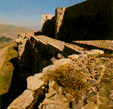
Considered dispassionately, the venture was impossible. The volunteers – a mixed assemblage of kings, nobles, mercenaries, and adventurers – had to cross thousands of miles of unfamiliar and hostile country and conquer lands of whose strength they had no conception. Yet so great was their fervor that in 1099 they took Jerusalem, establishing along the way principalities in Antioch, Edessa, and Tripoli. Although unable to fend off the Crusaders at first – even offering the Crusaders access to Jerusalem if they would come as pilgrims rather than invaders – the Muslims eventually began to mount effective counterattacks. They recaptured Aleppo and besieged Edessa, thus bringing on the unsuccessful Second Crusade.
In the meantime the Crusaders – or Franks, the Arabs called them – had extended their reach to the borders of Egypt, where the Fatimids had fallen after two hundred years. There they faced a young man called Salah al-Din (Saladin) who had founded still another new dynasty, the Ayyubids, and who was destined to blunt the thrust of the Crusaders’ attack. In 1187 Saladin counterattacked, eventually recapturing Jerusalem. The Europeans mounted a series of further crusading expeditions against the Muslims over the next hundred years or so, but the Crusaders never again recovered the initiative. Confined to the coast, they ruled small areas until their final defeat at the hands of the Egyptian Mamluks at the end of the thirteenth century.
Photo: The Crusader castle at Sidon in Lebanon was abandoned after the final defeat of the Crusader Kingdom of Jerusalem.
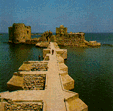
Although the Crusades achieved no lasting results in terms of military conquest, they were important in the development of trade, and their long-range effects on Western society – on everything from feudalism to fashion – are inestimable. Ironically, they also put an end to the centuries-old rivalry between the Arabs and Byzantines. By occupying Constantinople, the capital of their Christian allies, in the Fourth Crusade, the Crusaders achieved what the Arabs had been trying to do from the early days of Islam. Although the Byzantine Empire continued until 1453, when Constantinople fell to the Ottoman Turks, it never recovered its former power after the Fourth Crusade, and subsisted only in the half-light of history during its remaining years.
For the West, however, the Crusaders’ greatest achievement was the opening of the eastern Mediterranean to European shipping. The Venetians and Genoese established trading colonies in Egypt, and luxury goods of the East found their way to European markets. In the history of the Middle Ages, this was far more important than ephemeral conquests. Control of the Eastern trade became a constantly recurring theme in later relations between the European countries and the East, and in the nineteenth century was to lead to widespread Western intervention.

The Mongols & The Mamluks
In the thirteenth century still another threat to the Muslim world appeared in the land beyond the Oxus: the Mongols. Led by Genghis Khan, a confederation of nomadic tribes which had already conquered China now attacked the Muslims. In 1220 they took Samarkand and Bukhara. By mid-century they had taken Russia, Central Europe, northern Iran, and the Caucuses, and in 1258, under Hulagu Khan, they invaded Baghdad and put an end to the remnants of the once-glorious ‘Abbasid Empire. The ancient systems of irrigation were destroyed and the devastation was so extensive that agricultural recovery, even in the twentieth century, is still incomplete. Because a minor scion of the dynasty took refuge with the Mamluks in Egypt, the ‘Abbasid caliphate continued in name into the sixteenth century. In effect, however, it expired with the Mongols and the capture of Baghdad. From Iraq the Mongols pressed forward into Syria and then toward Egypt where, for the first time, they faced adversaries who refused to quail before their vaunted power. These were the Mamluks, soldier-slaves from the Turkish steppe area north of the Black and Caspian Seas with a later infusion of Circassians from the region of the Caucuses Mountains.
The Mamluks had been recruited by the Ayyubids and then, like the Turkish mercenaries of the ‘Abbasid caliphs, had usurped power from their enfeebled masters. Unlike their predecessors, however, they were able to maintain their power, and they retained control of Egypt until the Ottoman conquest in 1517. Militarily formidable, they were also the first power to defeat the Mongols in open combat when, in 1260, the Mongols moved against Palestine and Egypt. Alerted by a chain of signal fires stretching from Iraq to Egypt, the Mamluks were able to marshal their forces in time to meet, and crush, the Mongols at ‘Ayn Jalut near Nazareth in Palestine.
Photo: The Mamluks, originally a class of soldier slaves, seized power in Egypt in the thirteenth century and stood fast against the Mongols.
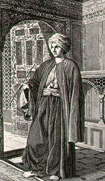
In the meantime, the Mongols, like so many of the peoples who had come into contact with Islam, had begun to embrace it. At the dawn of the fourteenth century, Ghazan Khan Mahmud officially adopted Islam as the religion of the state, and for a time peace descended on the eastern portion of the Mongol empire. During this period the Mongols built mosques and schools and patronized scholarship of all sorts. But then, in 1380, a new Turko-Mongol confederation was hammered together by another world conqueror: Tamerlane, who claimed descent from Genghis Khan. Under Tamerlane, the Mongol forces swept down on Central Asia, India, Iran, Iraq, and Syria, occupying Aleppo and Damascus and threatening – but not defeating – the Mamluks. Once again, however, the Muslims survived their invaders. Tamerlane died on his way to conquer China, and his empire melted away.
Politically and economically, the Mongol invasions were disastrous. Some regions never fully recovered and the Muslim empire, already weakened by internal pressures, never fully regained its previous power. The Mongol invasions, in fact, were a major cause of the subsequent decline that set in throughout the heartland of the Arab East. In their sweep through the Islamic world the Mongols killed or deported numerous scholars and scientists and destroyed libraries with their irreplaceable works. The result was to wipe out much of the priceless cultural, scientific, and technological legacy that Muslim scholars had been preserving and enlarging for some five hundred years.

The Legacy
The foundation of this legacy was the astonishing achievements of Muslim scholars, scientists, craftsmen, and traders during the two hundred years or so that are called the Golden Age. During this period, from 750 to 950, the territory of the Muslim Empire encompassed present-day Iran, Syria, Iraq, Egypt, Palestine, North Africa, Spain, and parts of Turkey and drew to Baghdad peoples of all those lands in an unparalleled cross-fertilization of once isolated intellectual traditions.
Geographical unity, however, was but one factor. Another was the development of Arabic, by the ninth century, into the language of international scholarship as well as the language of the Divine Truth. This was one of the most significant events in the history of ideas.
A third important factor was the establishment in Baghdad of a paper mill. The introduction of paper, replacing parchment and papyrus, was a pivotal advance which had effects on education and scholarship as far reaching as the invention of printing in the fifteenth century. It made it possible to put books within the reach of everyone.
Unlike the Byzantines, with their suspicion of classical science and philosophy, the Muslims were enjoined by the Prophet to “seek learning as far as China” – as, eventually, they did. In the eighth century, however, they had a more convenient source: the works of Greek scientists stored in libraries in Constantinople and other centers of the Byzantine empire. In the ninth century the Caliph al-Mamun, son of the famous Harun al-Rashid, began to tap that invaluable source. With the approval of the Byzantine emperor, he dispatched scholars to select and bring back to Baghdad Greek scientific manuscripts for translation into Arabic at Bayt al-Hikmah, “the House of Wisdom.”
Bayt al-Hikmah was a remarkable assemblage of scholar-translators who undertook a Herculean task: to translate into Arabic all of what had survived of the philosophical and scientific tradition of the ancient world and incorporate it into the conceptual framework of Islam.
As the early scholars in the Islamic world agreed with Aristotle that mathematics was the basis of all science, the scholars of the House of Wisdom first focused on mathematics. Ishaq ibn Hunayn and Thabit ibn Qurrah, for example, prepared a critical edition of Euclid’s Elements, while other scholars translated a commentary on Euclid originally written by a mathematician and inventor from Egypt, and still others translated at least eleven major works by Archimedes, including a treatise on the construction of a water clock. Other translations included a book On mathematical theory by Nichomachus of Gerasa, and works by mathematicians like Theodosius of Tripoli, Apollonius Pergacus, Theon, and Menelaus, all basic to the great age of Islamic mathematical speculation that followed.
The first great advance on the inherited mathematical tradition was the introduction of “Arabic” numerals, which actually originated in India and which simplified calculation of all sorts and made possible the development of algebra. Muhammad ibn Musa al-Khwaraznli seems to have been the first to explore their use systematically, and wrote the famous Kitab al-Jabr wa-l-Muqabalah, the first book on algebra, a name derived from the second word in his title. One of the basic meanings of jabr in Arabic is “bonesetting,” and al-Khwarazmi used it as a graphic description of one of the two operations he uses for the solution of quadratic equations.
The scholars at Bayt al-Hikmah also contributed to geometry, a study recommended by Ibn Khaldun, the great North African historian, because “it enlightens the intelligence of the man who cultivates it and gives him the habit of thinking exactly.” The men most responsible for encouraging the study of geometry were the sons of Musa ibn Shakir, al-Mamurl’s court astronomer. Called Banu Musa – “the sons of Musa” – these three men, Muhammad, Ahmad, and al-Hasan, devoted their lives and fortunes to the quest for knowledge. They not only sponsored translations of Greek works, but wrote a series of important original studies of their own, one bearing the impressive title The Measurement of the Sphere, Trisection of the Angle, and Determination of Two Mean Proportionals to Form a Single Division between Two Given Quantities.
The Banu Musa also contributed works on celestial mechanics and the atom, helped with such practical projects as canal construction, and in addition recruited one of the greatest of the ninth-century scholars, Thabit ibn Qurrah.
During a trip to Byzantium in search of manuscripts, Muhammad ibn Musa happened to meet Thabit ibn Qurrah, then a money changer but also a scholar in Syriac, Greek, and Arabic. Impressed by Thabit’s learning, Muhammad personally presented him to the caliph, who was in turn so impressed that he appointed Thabit court astrologer. As Thabit’s knowledge of Greek and Syriac was unrivaled, he contributed enormously to the translation of Greek scientific writing and also produced some seventy original works – in mathematics, astronomy, astrology, ethics, mechanics, music, medicine, physics, philosophy, and the construction of scientific instruments.
Although the House of Wisdom originally concentrated on mathematics, it did not exclude other subjects. One of its most famous scholars was Hunayn ibn Ishaq, Ishaq’s father – known to the West as Joanitius – who eventually translated the entire canon of Greek medical works into Arabic, including the Hippocratic oath. Later a director of the House of Wisdom, Hunayn also wrote at least twenty-nine original treatises of his own on medical topics, and a collection of ten essays on ophthalmology which covered, in systematic fashion, the anatomy and physiology of the eye and the treatment of various diseases which afflict vision. The first known medical work to include anatomical drawings, the book was translated into Latin and for centuries was the authoritative treatment of the subject in both Western and Eastern universities.
Others prominent in Islamic medicine were Yuhanna ibn Masawayh, a specialist in gynecology and the famous Abu Bakr Muhammad ibn Zakariya al-Razi – known to the West as Rhazes. According to a bibliography of his writings al-Razi wrote 184 works, including a huge compendium of his experiments, observations, and diagnoses with the title al-Hawi, “The All-Encompassing.”
A fountainhead of medical wisdom during the Islamic era, al-Razi, according to one contemporary account, was also a fine teacher and a compassionate physician, who brought rations to the poor and provided nursing for them. He was also a man devoted to common sense, as the titles of two of his works suggest. The Reason Why Some Persons and the Common People Leave a Physician Even If He Is Clever, and A Clever Physician Does Not Have the Power to Heal All Diseases, for That is Not within the Realm of Possibility.
The scholars at the House of Wisdom, unlike their modern counterparts, did not “specialize.” Al-Razi, for example, was a philosopher and a mathematician as well as a physician and al-Kindi, the first Muslim philosopher to use Aristotelian logic to support Islamic dogma, also wrote on logic, philosophy, geometry, calculation, arithmetic, music, and astronomy. Among his works were such titles as An Introduction to the Art of Music, The Reason Why Rain Rarely Falls in Certain Places, The Cause of Vertigo, and Crossbreeding the Dove.
Another major figure in the Islamic Golden Age was al-Farabi, who wrestled with many of the same philosophical problems as al-Kindi and wrote The Perfect City, which illustrates to what degree Islam had assimilated Greek ideas and then impressed them with its own indelible stamp. This work proposed that the ideal city be founded on moral and religious principles from which would flow the physical infrastructure. The Muslim legacy included advances in technology too. Ibn al-Haytham, for example, wrote The Book of Optics, in which he gives a detailed treatment of the anatomy of the eye, correctly deducing that the eye receives light from the object perceived and laying the foundation for modern photography. In the tenth century he proposed a plan to dam the Nile. It was by no means theoretical speculation; many of the dams, reservoirs, and aqueducts constructed at this time throughout the Islamic world still survive.
Photo: At Hama in Syria, antique wooden wheels still lift the waters of the Orontes to gardens, baths, and cooling fountains.

Muslim engineers also perfected the waterwheel and constructed elaborate underground water channels called qanats. Requiring a high degree of engineering skill, qanats were built some fifty feet underground with a very slight inclination over long distances to tap underground water and were provided with manholes so that they could be cleaned and repaired.
Agricultural advances are also part of the Muslim legacy. Important books were written on soil analysis, water, and what kinds of crops were suited to what soil. Because there was considerable interest in new varieties – for nutritive and medicinal purposes – many new plants were introduced: sorghum, for example, which had recently been discovered in Africa.
The introduction of numerous varieties of fruits and vegetables and other plants to the West via the Islamic empire was, however, largely the result of the vast expansion of trade during the Golden Age. This trade was vital; in the central lands of the ‘Abbasid empire natural resources such as metals and wood were scarce, and increases in urban populations had outstripped the capacity of the agricultural system to support them. The ‘Abbasids, therefore, were forced to develop extensive and complicated patterns of trade. To obtain food, for example, Baghdad had to import wheat from Syria and Egypt, rice from the Fayyum in Egypt, southern Morocco, and Spain, and olive oil from Tunisia. Called “a forest of olive trees,” Tunisia exported so much olive oil that its port of Sfax was called “the port of oil.”
To obtain scarce metals the ‘Abbasids had to turn elsewhere. They imported the technologically advanced “ondanique” steel from India, for example, and then processed it at such famous centers of weapons manufacture as Damascus and Toledo, both of which cities won fame for their blades. The ‘Abbasids also imported iron from Europe, tin from the British Isles and Malaya, and silver from northern Iran, Afghanistan, and the Caucuses. For gold, once the vast quantities in the treasuries of the conquered countries were exhausted, they turned to several sources. One was the gold mines of the Hijaz which were reopened around 750, reworked for about four hundred years, and then, in 1931, explored again by Karl Twitchell, who was searching for minerals in that area on behalf of King ‘Abd al-‘Aziz of Saudi Arabia.
For these necessities the ‘Abbasid traders exchanged a wide variety of products: pearls, livestock, paper, sugar, and (a specialty of the Islamic world) luxurious cloth. The traditional cloths were wool and linen – the latter an Egyptian specialty since ancient times – but cotton, which was introduced into upper Iraq about the time of the Prophet, later spread with Islam around the Mediterranean, to Syria, North Africa, Spain, Sicily, Cyprus, and Crete.
The cloth trade produced a number of auxiliary exports: gold and silver thread for embroidery, gum from the Sudan for glazing, and needles, looms, and dyestuffs. Closely connected with the trade in dyestuffs was the trade in medicines, an offshoot of ‘Abbasid advances in medicine and the spread of hospitals in all major Islamic cities. As scientific research and translation of medical texts from India and possibly even China expanded the earlier pharmacopoeia, ingredients for medicines were brought from all over the known world and also reexported.
Because the religious, political, and military achievements of the Islamic period loom so large in the history of the world, the extraordinary cultural, scientific, technological, and commercial achievements are frequently obscured or overlooked. Yet these advances were, in fact, of enduring significance to mankind as a whole. The destruction by the Mongols of many of these achievements and of much of what the Muslims had accomplished by the end of the Golden Age was a tragic loss for the world as a whole.

Architectural monuments spanning a thousand years bear witness to the spread of Islam.
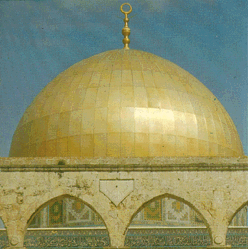
Photo: Jerusalem’s Dome of the Rock, built in 691-692.
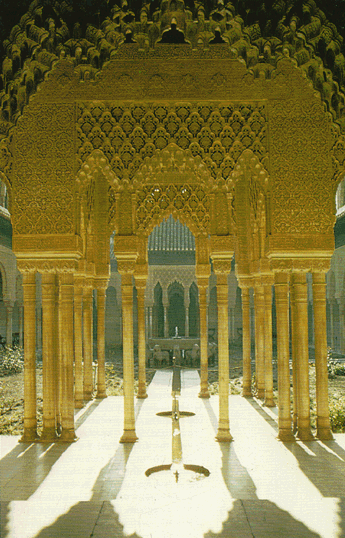
Photo: Water courses and fountains make an oasis of the Alhambra palace built at Granada in the fourteenth century Here incredibly light and elegant elements of Islamic decoration find their highest realization.
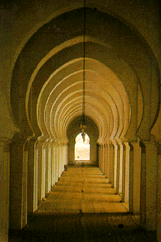
Photo: Purity of line characterizes the late twelfth century Kutubiyah Mosque of the Berbers in Marrakesh.
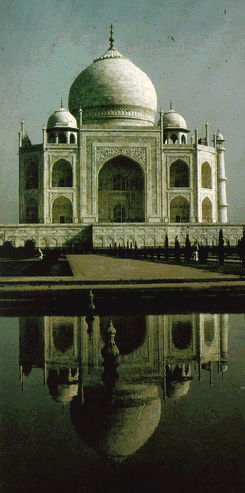
Photo: The peak of Mogul architecture and possibly the most famous work of all times and cultures is the dazzling Taj Mahal mausoleum built at Agra in 1629.

Photo: Sixteenth century Sultan Selim Mosque at Edirne is the apogee of Ottoman Turkish architecture, soaring space enclosed with a massive dome.
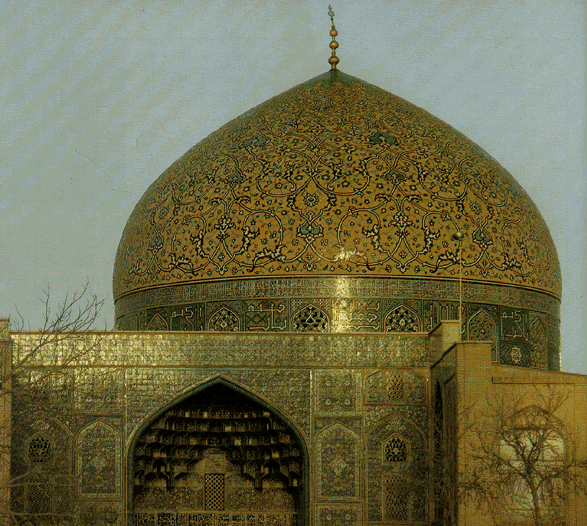
Photo: Persia’s greatest contribution to ornament, gloriously colored enameled tile, faces the dome and stalactite portal of Shaykh Lutf Allah Mosque, built in the early 1600s on Isfahan’s vast royal plaza.

The Ottomans
During the second Mongol invasion, Tamerlane had met and very nearly annihilated another rising power: the Ottomans. Under a minor chieftain named Othman, groups of Turkish-speaking peoples in Anatolia were united in the Ottoman confederation which, by the second half of the fourteenth century, had conquered much of present-day Greece and Turkey and was threatening Constantinople.
The Ottoman state was born on the frontier between Islam and the Byzantine Empire. Turkish tribes, driven from their homeland in the steppes of Central Asia by the Mongols, had embraced Islam and settled in Anatolia on the battle lines of the Islamic world, where they formed the Ottoman confederation. They were called ghazis, warriors for the faith, and their highest ambition was to die in battle for their adopted religion.
In addition to their military abilities the Turks seem to have been endowed with a special talent for organization. Towards the end of the Ottoman Empire, this talent fossilized into bureaucracy – and a moribund bureaucracy at that. But at the beginning, when its institutions were responsive to the needs of the people and the state, the Ottoman Empire was a model of administrative efficiency. This, together with a series of brilliant sultans – culminating in the redoubtable Suleiman the Magnificent – established the foundations of an empire that at its height was comparable to that of the Romans.
The first important step in the establishment of this empire was taken in 1326 when the Ottoman leader Orhan captured the town of Bursa, south of the Sea of Marmara, and made it his capital.
It was probably during the reign of Orhan that the famous institution of the Janissaries, a word derived from the Turkish yeni cheri (“new troops”), was formed. An elite corps of slave soldiers conscripted from the subject population of the empire, they were carefully selected on the basis of physique and intelligence, educated, trained, introduced to Islam, and formed into one of the most formidable military corps ever known. At a later period the Janissaries became so powerful that they made and unmade sultans at their will, and membership in the corps was a sure road to advancement.
Photo: The mosque at Kyustendi in Bulgaria was founded during Ottoman rule.

Orhan’s successor, Murad I, who launched naval attacks upon the Aegean coasts of Europe, established himself on the European shores of the Bosporus, and crushed a Balkan coalition. The next Ottoman leader was Bayazid I, who besieged Constantinople and routed the armies dispatched by an alarmed Europe to raise the siege.
It was at this point in history that Tamerlane and his Mongols advanced into Anatolia and very nearly crushed the Ottomans forever. They recovered, however, and later, under the leadership of a new sultan, Murad II, besieged Constantinople for the second time. They were repulsed, but by 1444 they had advanced into Greece and Albania, leaving Constantinople isolated though unconquered. Murad II was succeeded by Mehmed (Muhammad) II, called “The Conqueror” because on May 29, 1453, after his artillery finally breached Constantinople’s massive walls, the city fell.
After the fall of Constantinople, and during the sixteenth century, the Ottoman system evolved the centralized administrative framework by which the sultans maintained effective control over the extraordinarily diverse peoples in the vast empire.
An important part of this framework was the millet system – essentially a division of the empire into a communal system based upon religious affiliation. Each millet was relatively autonomous, was ruled by its own religious leader, and retained its own laws and customs. The religious leader, in turn, was responsible to the sultan or his representatives for such details as the payment of taxes. There were also, however, organizations which united the diverse peoples. Particularly important were the guilds of artisans which often cut across the divisions of religion and location.
There was also a territorial organization of the empire, at the upper levels of which was a unit called the muqata’ah under the control of a noble or administrator who could keep some portion of the state revenues derived from it. The amount varied with the importance of the individual noble or administrator, and he could use it as he saw fit. Such rights were also given to some administrators or governors in place of, or in addition to, salaries, thus insuring a regular collection of revenues and reducing record keeping.
The Ottoman Empire reached its peak in size and splendor under the sultan called Suleiman the Magnificent, who ruled from 1520 to 1566 and was known to the Turks as Suleiman the Law-Giver. But from the middle of the sixteenth century on the empire began to decline. This process got under way as the office of the Grand Vizier gradually assumed more power and indifferent sultans began to neglect administration. Another factor was that the Janissaries became too strong for the sultans to control The sultans were further weakened when it became customary to bring them up and educate them in isolation and without the skills necessary to rule effectively.
Some sultans later regained power through political maneuvering and by playing off factions against one another, but as a result administration was paralyzed. When Europe found a new route to India – thus eliminating the traditional transshipment of goods through the Arab regions of the empire, revenues began to fall, triggering inflation, corruption, administrative inefficiency, and fragmentation of authority.
Temporary reforms under various sultans, and the still formidable, if weakened, military prowess of the Ottomans helped maintain their empire. As late as 1683, for example, they besieged Vienna. Nevertheless, the decline continued. Because of the increasingly disruptive part played by the Janissaries, the empire, in a series of eighteenth-century wars, slowly lost territory. Because of administrative paralysis, local governors became increasingly independent and, eventually, revolts broke out. Even the various reform movements were balked, and with the invasion of Egypt in 1798 by France it became obvious that the once powerful empire was weakening.
In 1824 Mahmud II finally broke the power of the Janissaries, brought in German advisers to restructure the army, and launched a modernization program. He also brought the semi-autonomous rulers in various provinces under control, with the exception of the defiant and able Muhammad ‘Ali in Egypt. On the death of Mahmud, his sons continued his efforts with a series of reforms called the tanzimat. Some of these were no more than efforts to placate European powers – which by then had great influence on the empire’s policies – but others, in education and law, were important. Again, however, the effects were temporary and the empire continued to lose territory through rebellion or foreign intervention.
By the early years of the twentieth century the Ottoman Empire was clearly in decline and was referred to as the “Sick Man of Europe.” There were, however, some positive accomplishments in this period, such as the Hijaz Railway. Building the railway was undertaken in 1900 by Sultan Abdul-Hamid, as a pan-Islamic project. Completed in 1908, it permitted thousands of Muslims to make the pilgrimage in relative comfort and safety. It also helped to give the Ottoman government more effective control over its territories in western Arabia.
Photo: The Hijaz Railway, completed by the Turks in 1908, linked Damascus with Medina, eight hundred miles to the south.

During the early twentieth century too, a group called the Young Turks forced the restoration of the constitution (which had been suspended by Abdul-Hamid), eventually deposed the sultan, and again attempted to modernize the Ottoman state. The Turkish defeat in the First World War (in which the Ottoman Empire sided with Germany and the Central Powers) finally discredited the Young Turks, however, and paved the way for the success of a new nationalist movement under the leadership of an army officer named Mustafa Kemal, later known as Ataturk or “Father of the Turks.” The nationalist government under Ataturk, dedicated to leading Turkey in the direction of secularism and Westernization, abolished the sultanate, declared a republic, and eventually (in 1924) abolished the caliphate as well.

The Coming of the West
The Western world had for centuries been gradually penetrating most of the areas that had once been part of the Muslim empire, and in the latter part of the nineteenth century, in the vacuum left by the long decay and decline of the Ottoman Empire, European powers came to dominate the Middle East.
Among the first Europeans to gain a foothold in the Middle East were the Venetians who, as early as the thirteenth century, had established trading posts in what are now Lebanon, Syria, and Egypt, and who controlled much of the shipping between Arab and European ports. Then, in 1497, five years after Ferdinand and Isabella ended Islamic rule in Spain, Vasco da Gama led a fleet of four Portuguese ships around Africa and in 1498 found a new sea route to India from Europe. Dutch, British, and French frigates and merchantmen followed and began establishing trading outposts along the shores of the Indian Ocean, eventually undercutting both Venetian shipping and the Mediterranean trade on which the Middle East had thrived for millennia.
The process of European penetration was gradual and complex; but there were, nevertheless, clearly identifiable turning points. In the sixteenth century, for example, the Ottoman Empire voluntarily granted a series of concessions called the “Capitulations” to European powers – concessions which gave the Europeans decided advantages in foreign trade in the empire. Another turning point was the invasion of Egypt in 1798 by Napoleon Bonaparte. Hoping to cut Britain’s lines to India and cripple its maritime and economic power, Napoleon crushed the Mamluks (who governed Egypt under Ottoman suzerainty) and briefly occupied the country. By defeating Egypt, then still part of the Ottoman Empire, Napoleon exposed the inner weaknesses, both military and administrative, of the sultans, shattered the myth of Ottoman power, and inaugurated more than 150 years of direct political intervention by the West.
Europe’s worldwide nineteenth-century search for raw materials, markets, military bases, and colonies eventually touched most of what had been the Arab empire. In 1820 Great Britain imposed a pact on Arab tribes on the coast of the Arabian Gulf; in the 1830s France occupied Algeria; in 1839 Britain occupied Aden, at the strategic entrance to the Red Sea; and in 1869 Ferdinand de Lesseps, with the backing of the French emperor, completed what would become, and still is, one of the key shipping arteries of the world, the Suez Canal.
Western culture spread with Western economic and political control. In Lebanon missionaries from several countries founded a network of schools and universities. By introducing modern Western ideas these fostered the growth of Arab nationalism, contributed to the revival of Arabic literature, and provided a powerful impulse toward modernization. In addition to education, contact with the West led to improvements in medical care and the introduction of Western techniques in agriculture, commerce, and industry. For the most part, however, Western domination tended to benefit the nations of Europe at the expense of the Arab world. Although the Suez Canal, for example, has been of immense value to Egypt, the profits for nearly a century went to European shareholders in the company that managed the canal. Western and Western stimulated efforts to modernize parts of the Middle East, moreover, often led Middle Eastern rulers to incur debts which led to European financial control and then to European political domination. It was such a series of steps that ended with France occupying Tunisia in 1881 and Britain taking control of Egypt in 1882. Later, in emulation, Italy in 1911 seized Libya.
Resistance to European penetration took several forms. In the cities, Arab intellectuals debated whether modernization or a return to their roots would be the more effective path to the removal of foreign dominance and, consequently, to independence. Elsewhere, Muslim leaders such as the Mahdi in the Sudan and ‘Abd al-Qadir al-Jazairi in Algeria took direct action. These struggles were later romanticized and distorted in a wave of books and films on, for example, Gordon of Khartoum and the French Foreign Legion. Still other intellectuals, such as the Egyptian Muhammad ‘Abduh and his Syrian disciple Rashid Rida, undertook to reform the Muslim educational system and to restate Islamic values in terms of modern concepts – needs deeply felt by most Muslim thinkers of the nineteenth and twentieth centuries.
Western penetration also drew the Middle East into the First World War, when the Ottoman Empire sided with (Germany, and Great Britain, in response, encouraged and supported the Arab Revolt against the Turks. By promising aid – and ultimate independence from the Ottomans – Great Britain encouraged the Arabs to launch a daring guerrilla campaign against Turkish forces, a campaign widely publicized in press coverage of T. E. Lawrence (“Lawrence of Arabia”) and in Lawrence’s own writings.
By diverting Turkish strength and blocking the Turkish-German route to the Red Sea and India, the Arab Revolt contributed substantially to the Allied victory, but it did not result in full independence for the Arab lands. Instead, France and Great Britain secretly agreed to partition most of the Arab provinces of the Ottoman Empire between them and eventually obtained mandates from the League of Nations: Britain over Iraq, Palestine, and Transjordan; France over Syria and Lebanon. The mandates were inconsistent with British promises to the Arabs and, furthermore, contrary to the recommendations of President Wilson’s King-Crane Commission, a group sent to the Middle East in 1919 specifically to ascertain the wishes of the Arab peoples.
The mandates, however, were granted, thus extending Western control of the Middle East and also setting the stage for one of the most tragic and intractable conflicts of modern times: the conflict over Palestine which has, since 1948, ignited four wars, sent masses of Palestinian Arabs into exile, contributed to the energy crisis of 1973, and, from 1975 on, fueled the civil war in Lebanon.
The conflict over Palestine actually goes back to 1896, when Theodor Herzl published a pamphlet called Der Judenstaat (“The Jewish State”), in which he advocated British-backed Jewish colonization in Argentina or Palestine – with the hope of eventually creating a sovereign Jewish state. Herzl’s writings and personal advocacy led to the formal development of Zionism, a political movement dedicated to the creation of such a state, and eventually focusing on Palestine. The Zionist claim to Palestine was mainly based on the fact that there had been periods of Hebrew rule in Canaan and the land west of the Jordan River between 1300 B.C. and A.D. 70.
The Arabs considered this claim to be without substance. Palestine, they pointed out, had been part of the Islamic world almost continually for twelve centuries; from 636 to the First World War. In 1917, however, Lord Balfour, the British Foreign Secretary, issued the Baltour Declaration, which promised British support for the establishment of a “national home for the Jewish people” in Palestine providing that “nothing shall he done which may prejudice the civil and religious rights of existing non-Jewish communities” – a reference to the Arabs, who then were 92 percent of the population. The declaration was interpreted by key Zionist leaders as support for a sovereign Jewish state, but this interpretation has been disputed. Both Winston Churchill and Lord Balfour himself later said publicly that “a national home” meant a cultural or religious center, a view that America’s King-Crane Commission independently presented. Establishment of a national home did not imply a Jewish state, the commission said.
In the wake of the Balfour Declaration, and during the British mandate, Jewish immigration increased. So, in proportion did sporadic strife between Arabs and Jews. Immigration nevertheless continued and in the 1930s – with the rise of Adolf Hitler – and after World War II, Jewish immigration increased still further. As British efforts to control it generated widespread disapproval in the West and stimulated underground warfare by militant Zionist units against British forces, Britain eventually placed the problem in the hands of the United Nations, which in 1947 voted to partition Palestine into Jewish and Arab States.
Fighting then flared up in Palestine. Six months later, when Britain withdrew and formation of the State of Israel was proclaimed, the Arabs went to war against the newly declared nation. As Jewish forces were victorious – and as stories spread that some 250 Arab civilians had been massacred in a village called Deir Yassin – thousands of Palestinians fled, among the first of today’s 3.4 million refugees and exiles. Eventually the United Nations negotiated a truce, but fighting became endemic and war broke out again in 1956, 1967, and 1973. The 1967 war triggered underground warfare by Palestinian militants, whose attacks were primarily aimed at Israel, but also included strikes in Europe and hijackings on international air routes.
In order to settle the conflict, numerous United Nations Resolutions have been passed calling for peace, the return of the refugees to their homes, Israeli withdrawal from occupied territories, and the establishment of permanent boundaries. Several Western nations have attempted mediation, a Palestinian spokesman has argued the matter before the General Assembly of the UN, and in 1977 President Sadat of Egypt traveled to Jerusalem and appeared before the Israeli parliament in an unprecedented peace initiative. President Carter of the United States brought the leaders of Egypt and Israel together in the United States and himself traveled to the Middle East in an attempt to persuade at least these two countries to conclude a peace treaty, and in March 1979 Egypt and Israel signed a treaty to which the United States was also a signatory. Although it led to an improvement in Egyptian-Israeli relations which resulted in Israeli evacuation of some occupied Egyptian territory and the opening of the Suez Canal to Israeli ships, however, this separate peace treaty did nothing to bring about withdrawal of Israeli occupation forces from East Jerusalem, the West Bank, and the Golan Heights of Syria and left untouched the root cause of the entire problem- that is, the status of the Palestinians. The immediate net result of the treaty, in fact, was a general increase in tension in the Middle East which manifested itself in an apparent increase in Israeli intransigence in the occupied territories and the isolation of Egypt from the rest of the Arab world, including those countries on which it has been most heavily dependent for economic and political backing and which were opposed to the separate treaty because it failed to achieve a permanent and comprehensive peace.

Revival in the Arab East
Elsewhere in the Arab world, meanwhile, the last vestiges of European political dominance were being eliminated. Egypt, for example, after ousting in 1952 a royal dynasty going back to the 1800s and installing Gamal Abdel Nasser as president, forced the British to relinquish control of the Suez Canal and withdraw from the country. Algeria, ten years later, won its independence from France after six years of bitter warfare. Even earlier, Iraq, Syria, and Lebanon had broken their ties with Britain and France.
This tumultuous period also saw an increase in the influence of the United States and the Soviet Union in the Middle East. Neither power had played a major role in the early phases of penetration, but this changed as they developed conflicting interests with regard to the Arab-Israeli dispute, the construction of the Aswan Dam in Egypt, the rise of a number of radical governments in the area, and the emergence of the Arab world as a pivotal supplier of oil to the world.
In the same period, the Arab countries themselves, voluntarily and pragmatically, continued to adopt Western techniques, forms, and to some extent concepts. Most Arab countries, for example, have embraced the concept of the sovereign nation-state and Western patterns of political administration: parliaments, political parties, and constitutions. Many, too, have adopted Western legal codes, have accepted international and regional organizations and international courts as means of dealing with other nations, and have organized and equipped their armed forces along Western lines. In recent years, most Arab countries have also adopted the modern industrial economy as a national goal and introduced modern techniques of agriculture and modern methods of transport and mass communications, and invested vast sums in education. Even in recreation and amusement, Western influences are strong.
If Western influences are important in the Middle East, however, they are by no means paramount. Western forms have been adapted as much as they have been adopted, and healthy hybrid forms and concepts abound. More importantly, traditional values are still deeply cherished and promoted. In sum, modernization has not been entirely synonymous with Westernization. By the end of the 1970s the Arabs, having assumed control of their own destinies, had emerged as full and independent participants in the affairs of the world. In the forefront was Saudi Arabia, the heartland of Islam, and the site of the momentous events which initiated Islamic history fourteen centuries ago.
In the sixteenth century three Muslim empires are at or close to the pinnacle of their power and brilliance: the Ottomans under Suleiman the Magnificent, Safavid Persia under Shah Abbas the Great, and Mogul India under Akbar the Great. The Ottoman Turks have conquered and maintain effective control over diverse peoples in a vast empire stretching from Persia almost to the gates of Vienna and along the north coast of Africa to Algiers. In the Arabian Peninsula the Ottomans penetrate to al-Hasa on the Arabian Gulf and to Mocha on the Red Sea. However, the sharifs of Mecca and Medina are virtually independent. Throughout this period the Ottomans contest control of the Arabian Gulf and the Red Sea with the Portuguese, who establish themselves in Bahrain, Muscat, and Hormuz and assist Ethiopia in repulsing the Turks from the coast of East Africa.
Islam numbers many millions of adherents outside the Middle Eastern countries.

Photo: Sunset silhouettes a minaret in Sarajevo, a city of some eighty mosques that bear witness to the long Islamic heritage of Bosnia and Herzegovina.
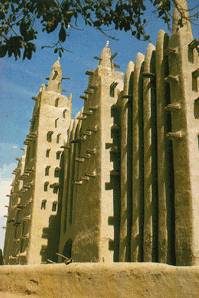

Photo: The Mopti Mosque in the West African Republic of Mali.
Photo: A Taiwanese religious teacher.
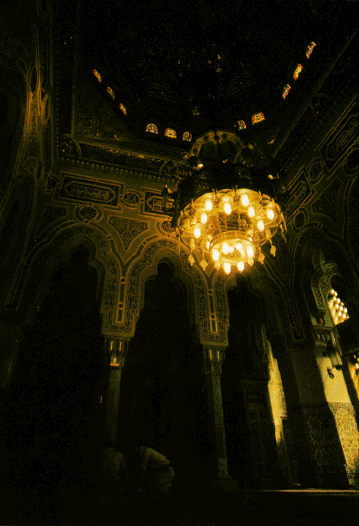
Photo: A mosque in Washington, D.C., a landmark for millions of Muslims in North America.

Photo: One of the largest mosques of the Far East is in Bandar Seri Bagawan, capital of the Sultanate of Brunei in Southeast Asia.
Acknowledgements:
These pages were incorporated from “ARAMCO and Its World: Arabia And The Middle East”, Edited by Ismail I. Nawwab, Peter C. Speers & Paul F. Hoye, Islam and Islamic History Section, published in 1980 by Arabian American Oil Company, Washington D.C.

